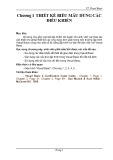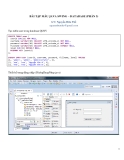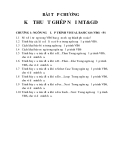
TRƯỜNG ĐẠI HỌC KỸ THUẬT CÔNG NGHIỆP
KHOA ĐIỆN TỬ
------------o0o--------------
TÀI LIỆU
HƯỚNG DẪN BÀI TẬP
TÊN HỌC PHẦN: CÁC MÔ HÌNH MÁY TÍNH THẾ HỆ MỚI
MÃ HỌC PHẦN: ………………...
NGƯỜI BIÊN SOẠN: TĂNG CẨM NHUNG
BỘ MÔN:TIN HỌC CÔNG NGHIỆP
Lưu hành nội bộ

Sách bài tập môn Các Mô hình MT-THM
BM Tin học công nghiệp
T r a n g | 2
TRƯỜNG ĐẠI HỌC KỸ THUẬT CÔNG NGHIỆP
KHOA ĐIỆN TỬ
------------o0o--------------
TÀI LIỆU
HƯỚNG DẪN BÀI TẬP
TÊN HỌC PHẦN: CÁC MÔ HÌNH MÁY TÍNH THẾ HỆ MỚI.
MÃ HỌC PHẦN: ………………...
Thái nguyên, ngày …. tháng…. năm 2014
TRƯỞNG BỘ MÔN
TIN HỌC CÔNG NGHIỆP.
VŨ VIỆT VŨ
NGƯỜI BIÊN SOẠN
TĂNG CẨM NHUNG
Lưu hành nội bộ

Sách bài tập môn Các Mô hình MT-THM
BM Tin học công nghiệp
T r a n g | 3
LỜI NÓI ĐẦU
Sinh viên chuyên nghành KTMT đã được tiếp cận môn học Kiến trúc máy tính
trong phần cơ sở. Trong môn học này người học được tiếp cận với mô hình máy tính
đơn bộ xử lý và chỉ có khả năng tính toán tuần tự. Với quy luật và xu hướng phát triển
của máy tính hiện nay, kiến trúc và khả năng xử lý của hệ thống máy tính ngày càng
được nâng cao để đáp ứng nhu cầu về xử lý, tính toán của con người.
Trong môn học Các mô hình máy tính thế hệ mới, người học được cung cấp
những kiến thức liên quan đến mô hình kiến trúc máy tính nâng cao. Đối với kiến trúc
này, hệ thống máy tính đề được thiết kế với nhiều Bộ xử lý, nhiều bộ nhớ và hệ thống
mạng liên kết giữa chúng. Ngoài ra, khả năng xử lý song song là một ưu điểm của hệ
thống máy tính tiên tiến.
Để có thể hiểu và nắm vững lý thuyết về kiến trúc, nguyên lý, cách thức trao
đổi thông điệp giữa các BXL trong hệ thống ngoài việc cần nắm vững kiến thức về lý
thuyết, người học cần phải hiểu rõ cách thức thiết kế các bộ đa xử lý, cách thức xây
dựng mạng liên kết và đặc biệt phải tính được hiệu suất làm việc của các Bộ xử lý khi
chúng phải xử lý đồng thời nhiều tập lệnh trong cùng một điểm
Trong phần bài tập được đưa ra dựa trên đề cương môn học sẽ đáp ứng được
các yêu cầu trên thông qua các bài tập của từng chương.

Sách bài tập môn Các Mô hình MT-THM
BM Tin học công nghiệp
T r a n g | 4
MỤC LỤC
CHƯƠNG 1. GIỚI THIỆU KIẾN TRÚC MÁY TÍNH TIÊN TIẾN VÀ XỬ LÝ SONG SONG. ..........5
1.1 Tóm tắt lý thuyết ....................................................................................................................5
1.2 Các dạng bài tập (có hướng dẫn giải) ...................................................................................5
1.3 Các vấn đề về thảo luận, thực hành, thí nghiệm..................................................................5
1.4 Bài tập sinh viên tự làm .........................................................................................................5
CHƯƠNG 2. KẾT NỐI MẠNG ĐA XỬ LÝ ..........................................................................................8
2.1 Tóm tắt lý thuyết ....................................................................................................................8
2.2 Các dạng bài tập (có hướng dẫn giải) ...................................................................................8
2.3 Các vấn đề về thảo luận .........................................................................................................8
2.4 Bài tập sinh viên tự làm .........................................................................................................8
CHƯƠNG 3. PHÂN TÍCH HIỆU XUẤT CỦA KIẾN TRÚC ĐA XỬ LÝ ........................................ 17
3.1 Tóm tắt lý thuyết ................................................................................................................. 17
3.2 Các dạng bài tập (có hướng dẫn giải) ................................................................................ 17
3.3 Các vấn đề về thảo luận, thực hành, thí nghiệm............................................................... 17
3.4 Bài tập sinh viên tự làm ...................................................................................................... 17

Sách bài tập môn Các Mô hình MT-THM
BM Tin học công nghiệp
T r a n g | 5
CHƯƠNG 1. GIỚI THIỆU KIẾN TRÚC MÁY TÍNH TIÊN TIẾN
VÀ XỬ LÝ SONG SONG.
1.1 Tóm tắt lý thuyết
Chương 1 đề cập đến các vấn đề cơ bản:
• Các kỷ nguyên phát triển của máy tính dựa trên cách thức hoạt động và kiến trúc.
• Phân loại Kiến trúc máy tính dựa trên khả năng xử lý dữ liệu, như là
- Kiến trúc SISD
- Kiến trúc SIMD
- Kiến trúc MISD
- Kiến trúc MIMD
• Các kết nối mạng của các BXL và bộ nhớ trong hệ Đa xử lý, cụ thể
- Các phương thức hoạt động
- Chiến lược kiểm soát
- Kỹ thuật chuyển mạch
- Topo
1.2 Các dạng bài tập (có hướng dẫn giải)
1.3 Các vấn đề về thảo luận, thực hành, thí nghiệm
1.4 Bài tập sinh viên tự làm
Trình bày các kỷ nguyên phát triển khác nhau của máy tính. Kỷ nguyên nào được xem
là kỷ nguyên bắt đầu của hệ thống máy tính song song?
Câu 1.1. Các kiến trúc máy tính có thể được phân loại như thế nào? Dựa vào những
yếu tố nào để phân loại?
Câu 1.2. Trình bày phân loại kiến trúc máy tính của Flynn? Theo cách phân loại này
thì một máy tính cá nhân với chip Dual-core (hai nhân) hiện nay thuộc loại nào?
Câu 1.3. Phân biệt 4 mô hình SISD, SIMD, MISD, MIMD
Câu 1.4. Bộ nhớ máy tính song song được chia thành những mô hình nào ?
Câu 1.5. Nêu nguyên tắc tổ chức bộ nhớ dùng chung?
Câu 1.6. Nêu nguyên tắc tổ chức bộ nhớ phân tán (Bộ nhớ truyền thông điệp)?
Câu 1.7. Trình bày về kiến trúc SIMD. Hãy so sánh ưu và nhược điểm của máy tính
SIMD với bộ nhớ phân tán và bộ nhớ chia sẻ?
Câu 1.8. Trình bày về kiến trúc SIMD. Hãy so sánh ưu và nhược điểm của máy tính
SIMD với bộ nhớ phân tán và bộ nhớ chia sẻ?
Câu 1.9. Hãy tìm một ứng dụng thực tế có thể thực hiện trên máy SIMD với bộ
nhớ chia sẻ.




![Bài tập thực hành Visual Basic .NET: Tổng hợp [kèm ví dụ]](https://cdn.tailieu.vn/images/document/thumbnail/2013/20130202/lqvang02/135x160/6051359780512.jpg)











![Tài liệu ôn tập môn Lập trình web 1 [mới nhất/chuẩn nhất]](https://cdn.tailieu.vn/images/document/thumbnail/2025/20251208/hongqua8@gmail.com/135x160/8251765185573.jpg)









